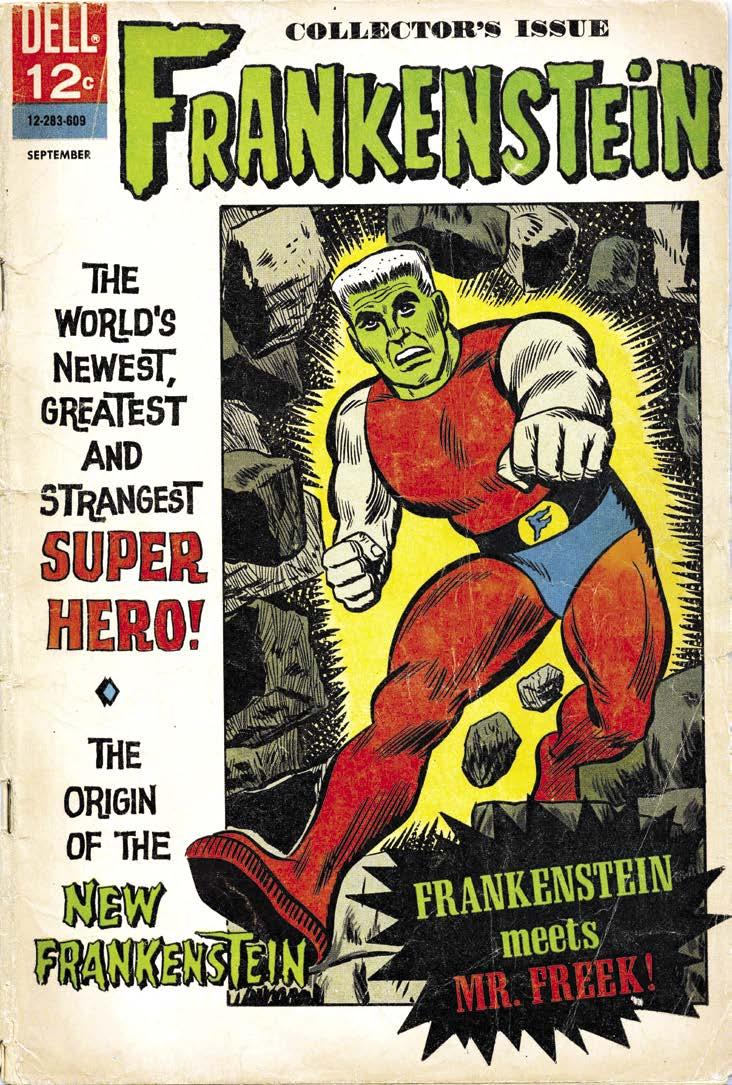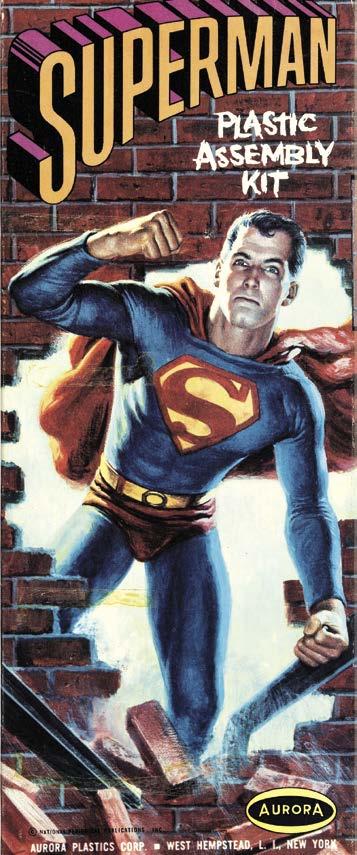































TV moms in the Sixties were a mixed bag: perfect housewives (June Cleaver), nose-twitching witches (Samantha Stevens), neurotics in Capri pants (Laura Petrie), vampires (Lily Munster).
Along came Carol Brady in the blonde, lithe person of Florence Henderson. Carol was sexy (she took good care of Hubby #2), talented (she sang in the Christmas recital), and above all, she effortlessly slid into the treacherous role of Understanding Stepmother to three rambunctious adoptive boys.
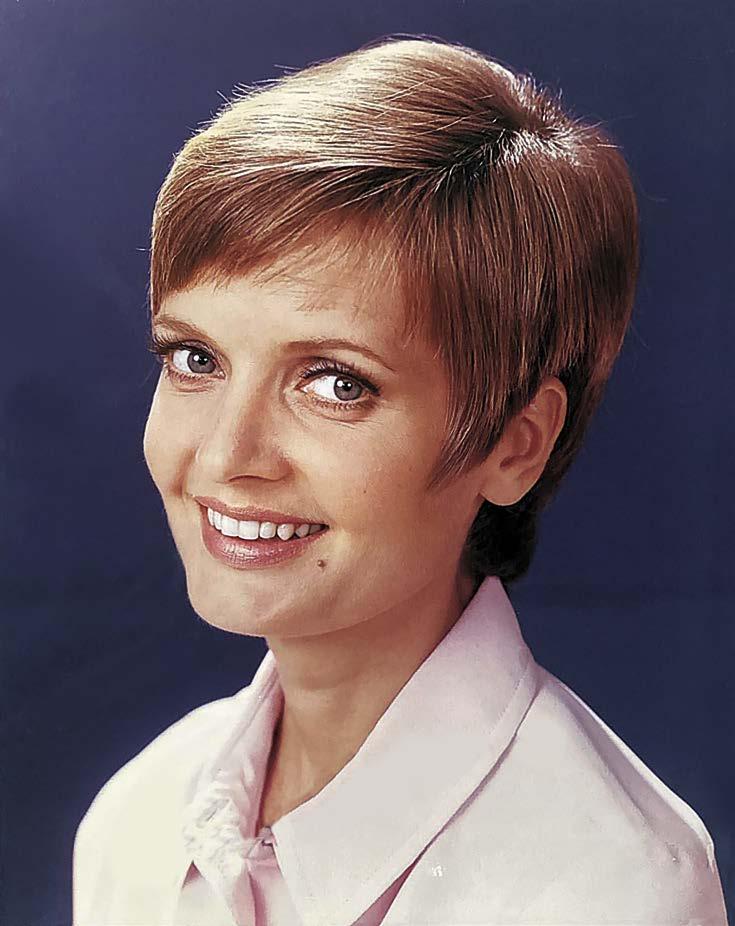
I interviewed Indiana native Henderson (1934–2016) on two occasions, in 1993 and 2000. During our first conversation, I found myself apologizing after the fifth or sixth Carol Brady question. But Henderson put me at ease.
“I realize that it’s such a part of our culture, of our television culture,” the actress said. “It seems to mean so much to people.”
(LEFT) Henderson and Robert Reed as Carol and Mike Brady. (BELOW) (CLOCKWISE FROM TOP LEFT) Ann B. Davis, Barry Williams, Robert Reed, Eve Plumb, Maureen McCormick, Mike Lookinland, Susan Olsen, and Christopher Knight. At center is Florence Henderson.


“I just feel that every day is a great day, and tomorrow is going to be an even better one,” she said. “I’m not a Pollyanna; I’ve had a lot of hard times in my life, a lot of tragedies in my life. But I’ve never really lost that joy. I think that comes across. You can only build on your character from what you are, and Carol Brady was not so dimensional.”
Henderson was also able to make Carol a sexy mom, no small feat considering the era. “That was kind of tough,” she said, “because we were restricted by the times and the codes of television. There were many things we couldn’t do and many things we couldn’t say.
“But I could infer, for instance, when we would have a scene in bed, that Mike and I were going to go to bed and have sex, and that Carol Brady was really going to enjoy it.”
Among Henderson’s fondest memories of shooting the original series were those episodes filmed on location.
“At King’s Island [an amusement park in Cincinnati], we came to realize the popularity of the show,” she said. “Because that park was filled with people, and we simply could not leave our rooms! They had to get security guards when we were in the park performing. They [fans] would find out our hotel rooms and come banging on the doors. We were totally surprised by that, because we were pretty insulated in the studio.
“Then we went to the Grand Canyon. I loved that, because I love mountains. It was my first trip there. I couldn’t get over the beauty of it.”
Still, there were downsides. “They made us get on those mules,” Henderson said. “Have you ever seen those mules? They’re gigantic! I thought it was going to be this little mule. I had to get on a ladder to get on it.
“They put the mule skinner first, then Robert Reed, then Ann B. Davis, then the six kids, and I was last. And when we started down the trail, you look straight down to the bottom of the canyon. My mule kept leaning over and eating, chewing leaves and things. I thought, I can see the headline: ‘Florence Henderson Falls Off Mule to Her Death in Grand Canyon.’
“And I kept yelling—the mule skinner’s name was Al— I go, ‘Al! Al! He’s eating!’ Al would say, ‘Jerk his head up. Jerk up his rein. He won’t fall.’ I was scared to death. By the time we got done that scene and I got off the saddle, it was not dry.”
In his 1992 memoir Growing Up Brady written with Chris Kreski, Barry Williams revealed that Reed (who died that same year) frequently clashed with Schwartz and his son, producer Lloyd Schwartz, over the quality—and particularly the believability—of the scripts.
“Bob was always in conflict,” Henderson admitted. “He loved everybody on the show and he loved it when we all got back together. I think we were Bob’s family. And yet, at times, I think he was frustrated that he wasn’t doing Shakespeare. He never quite accepted the fact that The Brady Bunch was a simple little show, and it was sometimes funny and sometimes touching. He always wanted to make more out of it, which would have been wrong for the show.
“But I do believe Bob’s heart was always in the right place. He argued because he thought he was improving the show, improving scenes. And sometimes, he did. But he got carried away from time to time.”
(TOP LEFT) King-Seeley Thermos depicted the wedding scene from the pilot episode. (TOP RIGHT) Carol and Mike Brady share an ice cream soda on card #10 of Topps’ Brady Bunch trading card series. (LEFT) Detail of a splash page from Dell’s Brady Bunch comic book. (RIGHT) Issue #1 of Dell’s Brady Bunch comic book (1970). © Paramount Television;


One of those occasions was the final episode of The Brady Bunch, which was filmed in 1974. Following yet another blowout with the Schwartzes, Reed was abruptly written out of the episode, though he stayed on set and observed the shooting from the sidelines.

As Henderson told it: “Sherwood came to Ann B. and me and said, ‘I’m going to write Bob out of the show, because he doesn’t

When I was growing up in the early Sixties, the big name in cartoons was Hanna-Barbera Productions, a partnership headed by William Hanna and Joe Barbera, who transitioned from doing Tom and Jerry movie cartoons to animated shows produced especially for television when the market for theatrical short subjects collapsed in the Fifties.
Starting with The Ruff and Reddy Show in 1957, the dedicated duo steadily built an animation empire. Then they got an unusual idea: prime-time TV cartoon shows.
Taking Jackie Gleason’s Honeymooners as a template, they came up with the prehistoric program they called The Flintstones. It was an unqualified hit and ran six seasons. Naturally, they attempted to duplicate that success. But The Jetsons and Jonny Quest lasted only one season each.
Another animated character Hanna-Barbera launched in primetime also flopped in the evening time slot. Strangely, that marked only a prologue to the career of Top Cat.

Inspired by Phil Silvers’ Fifties sitcom You’ll Never Get Rich (a.k.a. The Phil Silvers Show), Top Cat took the concept of a conniving but lovable peacetime U.S. Army hustler to the urban streets of New
York City. Tricked out only in a straw boater and purple vest, Top Cat—aka T. C.—hung out in Hoagy’s Alley, near the 13th Precinct Station, with his “Cat Pack” of assorted alleycat moochers, hangers-on, and swindlers, which included Benny the Ball, ChooChoo, Fancy-Fancy, Spook, and Brain. Their perennial nemesis was Officer Charlie Dibble, whose Broadway beat included the trash-can-strewn alley where T. C. and his boys plied their sneaky trade, mooching doorstep milk and free phone calls from Dibble’s police call box.
Joe Barbera recalled that the series was launched from the flimsiest of triggers. An ABC executive was visiting the Hanna-Barbara studios and asked to use Barbera’s office to make a phone call.
“While he was there,” Barbera related, “I saw this drawing of Top Cat. One drawing, just standing sideways looking, and it said ‘Top Cat’ at the bottom. We never used it. All I remember is this one drawing at the time, in color. And I went in to Ollie [Treyz, TV executive] and I said, ‘Here’s a terrific character.’ He just looked at it and said, ‘Yeah. Looks good. We’ll buy it.’ That’s the end of it. So a prime-time show with one drawing. Then after that, we had to go in and develop all the characters and go to storyboard, but it was sold.”
“I’ve made up my mind—and with the blessings of Hanna and Barbera—that this is one role that won’t be played into another ‘Arnold Stang character,’” Stang added. “Top Cat will be different. He’ll be my first hero. He will be authoritative—a decision maker, a leader. What I want to do with T. C. is to give him a certain seedy grandeur. Unlike the characters I’ve played in the past—some sympathetic and some not so—T. C. is an expert at making big, big plans; he’s a lovable rogue with an eye for the shortcut to pleasure.”
According to the actor, the original Top Cat design was scrapped when he took on the role, although this may have been limited to a change in outfit.


“When they decided to use me,” revealed Stang, “they discarded the earlier animation. They felt I brought a new quality to the part, a sort of seedy grandeur, a shabby aristocracy. So they changed and redrew the character. Instead of a torn hat, he wore a straw with an Ivy League band. Instead of old clothes, he was given a colored weskit and an old school tie, so that he achieved a kind of shabby sophistication.”
HE’s tHE BOss, HE’s A VIP, HE’s A CHAMPIOnsHIP T. C. kept his vagrant lifestyle, however.
“Top Cat lives in an alley behind the bowling center and next to a policeman’s call box,” explained Joe Barbera. “The policeman is Officer Dibble, who is always admonishing him about using the
It was 1959. The war was over. America was prosperous and people felt secure. Making do and doing without were out, and fun was in. Hawaii joined the Union. Nixon engaged in a Kitchen Debate with Khrushchev. The Guggenheim temple to modern art opened in New York City. Twilight Zone and Bonanza were on those new little screens in people’s living rooms, while on the big screen Charlton Heston was Ben Hur and Doris Day and Rock Hudson shared some Pillow Talk. On March 9, at the Toy Fair in New York, the First Lady of Fashion debuted—Barbie, whose career, more than a billion dolls later, is still in the ascendant.
At the beginning, Barbie’s career had seemed less than promising, for when Ruth Handler (who died in 2002 at the age of 85) had first presented her idea for a grown-up fashion doll with a wardrobe, she had been informed by the condescending engineers at Mattel that little girls would rather play with baby dolls.


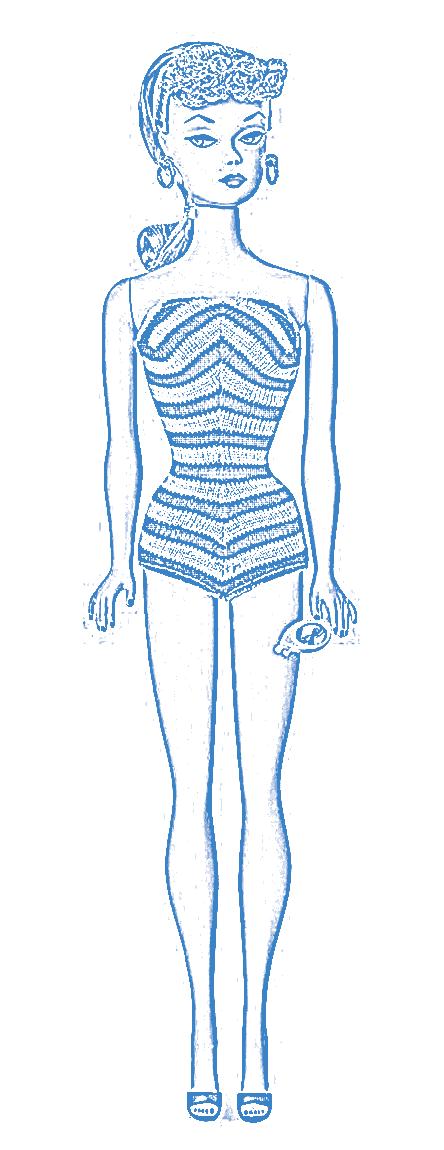
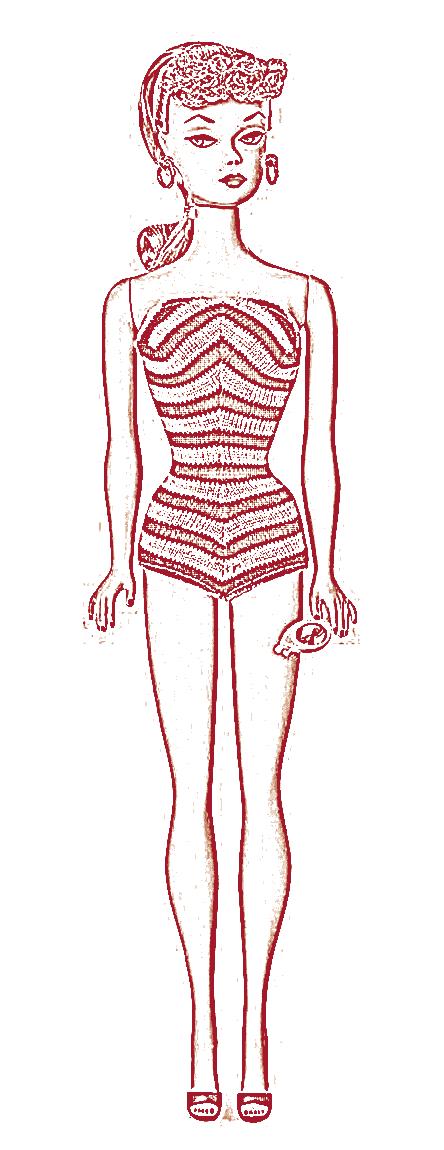

Ruth was not easily discouraged, though. She, with her husband, Elliot, owned Mattel, a company which they had created in their garage (Elliot made housewares out of Plexiglas) and which would grow into a multi-billion-dollar corporation. The vision which Ruth had presented to the engineers—a lady doll with a fashionable wardrobe—was born of her observation of her daughter Barbara’s play: little

Barbara shunned baby dolls, preferring to play role-playing games with her adult paper dolls. Ruth thought that it would be nice for her daughter to have a three-dimensional adult doll, rather than only paper dolls with which to play. And then, in 1956, while vacationing in Switzerland, Ruth happened upon a Bild Lili doll in a shop. Lili was an adult gag gift, a shapely Betty Boop, produced in Germany from 1955–1964.
Ruth purchased the doll, brought it back to Mattel, and told the engineers that she wanted them to create a doll the same size (11 1/2″) with a different face and personality. At the next Toy Fair, in 1959, the wholesale buyers—who were looking at Barbie for the very first time—also told a frustrated Ruth that little girls would rather play with baby dolls, and their orders were not what she had hoped for.

Ruth knew little girls better than they did, though, and through a massive advertising campaign on television’s The Mickey Mouse Club, Mattel introduced Barbie directly to the little girls of America, rather than to parents and buyers. Up until this time, manufacturers had not marketed directly to children. Little girls went wild—and demanded that their parents buy them Barbie!
MARKE tInG tO CHILDRE n
“Barbie, you’re beautiful. You make me feel
My Barbie doll’s really real. . .

Someday I’m gonna be Exactly like you.
’Til then, I know just what I’ll do, Barbie, beautiful Barbie, I’ll make believe that I am you.”
These lyrics are sung as Barbie’s first devotees catch their first glimpse of a Number One blonde ponytail, wearing “Suburban
(LEFT) Barbie® creator Ruth Handler and friends, in the Mattel office, mid-Sixties. Courtesy of UCLA Library Special Collections. (CENTER) Reproductions of the original 1959 Barbie continue to be valued by collectors to this day. © Mattel. (RIGHT) This 1959 newspaper ad promoted Mattel’s new “living doll,” Barbie—retailing for a mere three bucks!
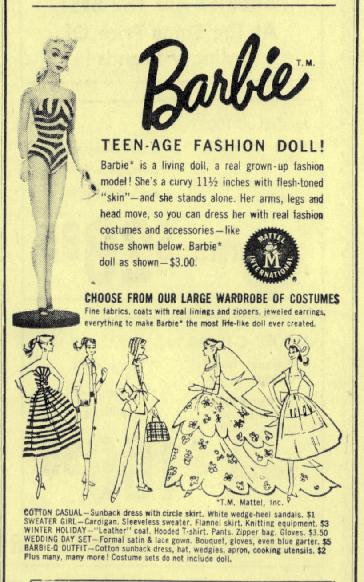
Shopper” and holding a bouquet of roses. The camera pans away to reveal a Ziegfeld-esque staircase on which other Barbies pose in “Nighty Negligee,” pink satin “Enchanted Evening,” and sporty ski cabin “Winter Holiday” ensembles. A girl’s hand reaches for—grasps—and lifts the Enchanted Evening doll! The singer continues her serenade, as Barbie is presented dressed in the other outfits in her wardrobe. Barbie sold for $3.00 and her fashions for $1.00–$5.00. As the commercial ends, a brunette Barbie is shown in a full-skirted wedding gown. Ruth Handler’s sales plan was based on the “razor and blade” concept—when a doll was sold, sales of her fashions and accessory play sets would continue indefinitely. In 1962, a commercial introduces “Barbie’s Boyfriend,” Ken (“He’s a Doll!”), the voice-over letting us know that the couple met at a dance, have lunch at school, go to dances, and “just relax together… Think of all the fun you’ll have taking Barbie and Ken on a date.”
Ken requires a full wardrobe, too, to complement each of Barbie’s ensembles. A fantasy world has been established for generations of young girls (and their brothers, who often join their sisters in Barbie games). The commercials conclude with the mantra, “You can tell it’s Mattel: it’s swell!”
Mattel employed Ernst Dichter, a pioneer of psychology-based marketing, to develop their direct-marketing-to-children campaign. Their target cohort was girls ages 7–12, on the brink of


My first introduction to Murray Langston, the Unknown Comic, was from watching his performances on The Gong Show in the mid-to-late Seventies.
Back in 1981, my junior high school had a talent show in which anyone from the seventh or eighth grade could participate. A buddy of mine suggested that we do a stand-up comedy act since we were considered the class clowns at the time. There were five of us in the group and we came up with the idea of going as “Unknown Comics.” We tried doing the rehearsals with paper bags over our heads, but due to the heat the bags would make us sweat profusely and make it hard to breathe. When it was closer to the date of the performance, we decided that maybe it was best with only two or three of us doing the act, and so yours truly and one other sat in the audience and watched our three other friends bomb with bad jokes.
Years later, I decided to look up the real Unknown Comic on the internet. I discovered him on Facebook under his real name of Murray Langston. So I reached out to him in early 2022, and to my surprise he was willing to give me an hour on the phone to answer my questions.
The below interview, conducted on June 16, 2022 and transcribed by Rose Rummel-Eury, is the result of that chat. As you’ll read, today Murray Langston is still doing stand-up at comedy clubs in his area. Hopefully one day he’ll take it on the road for the rest of us RetroFans.
RetroFan: I see that you were born in Canada…
Murray Langston: Yes, I was actually born in Dartmouth, Nova Scotia, on the upper coast, but was raised in Montreal and Toronto in my early years. Then I came to the States to see if I could break into show business.
(ABOVE) Reading material in a brown bag is usually the kind of stuff you’d hide from your mother, but not Journey Thru the Unknown…, the memoir of Murray Langston—better known to most RetroFans as the Unknown Comic. © Murray Langston. Courtesy of Shaun Clancy.
RF: As a child, were you interested in comedy?
ML: As a child, I was very young, as I recall. [laughter]
You know, I was heavily influenced by [Dean] Martin and [Jerry] Lewis. I was about ten or 11 when they broke out and I was mesmerized. I said, “That’s what I want to do; I want to go to Hollywood.” That was my goal from that point on. I had to figure a way to get there, but that took
I wanted to be in the business. I knew I wanted to be like Jerry Lewis—entertain, get in the movies, but when you’re 17 and 18, you have no clue.
I remember toward the end of my career in the military, that they were looking for members of a group called the Monkees, and I sent in for it and got an invitation for an audition call. I was already playing the drums, but, of course, they cast Micky Dolenz. I remember getting the invitation: “Come on down,” but I still had a couple weeks left in the military.
RF: Was there anyone else on your ship with an interest in show business?
ML: No, no. The interesting thing about it, during those years, Bob Hope entertained on our ship, and because I was in Special Services, I had to deal with all that. Tuesday Weld was there, and I had my picture with her. She was a very famous, young, sexy actress. I got to be associated with Bob Hope while getting the stage set. Years later, I was worked with him on a TV show.
RF: Was Hope’s personality the same off screen as he was on screen? Was he always kidding around or was he serious?
ML: He was always trying to get laid, as I recall, with all these sexy young things around him! Maybe that’s why I wanted to get into show business! It just seemed to be a fun way to spend your life, so that’s the direction I headed in.
RF: After being discharged, did you head to L.A.?
ML: I was playing in a band. Back then, the most popular band was the Young Rascals. They were huge and I got to see them and hang backstage. Interestingly, I got to work with the lead singer on a cruise ship a couple of years ago.
Anyway, I was in the band and had saved up some money but the band was about to break apart. I had saved up a couple thousand dollars and mentioned it to friends in public. Next thing I knew, I had a gun to my back, and had a couple guys rob me of my money because of my own stupidity. I had a TV set and a few things and managed to scrape up a few hundred dollars.
Instead of flying to L.A., I had to take a bus for $50. I went from New York to L.A., which took days, and arrived late at night
with less than $100 in my pocket, with no clue what, where, when, to do next—derelicts everywhere, and it was raining.
I arrived in Hollywood and went out and bought myself loaves of bread and bologna and lived off that for a week. I got a little room downtown. It was not the way I envisioned Hollywood. It was what it was. I would never have sought it out for me—I was very independent.
I ended up getting a job at an insurance company, in the computer section. This was in the early days with data cards, and I got a job for $50 a week working with computer cards. I was there for a year or so, trying to get settled and get into show business. [One day,] three of the computer operators got into a fight with management and left. I had no clue what to do, but I had watched them. Next thing I knew, they put me in computer
operations, and instead of a card boy, I was a computer operator.
I spent the next two months learning, and then saw a job [posting] at Universal Studios, looking for computer operators. I thought, “That’s what I’ll do. I’m a computer operator. At least I’ll get to hang out with celebrities.”
That’s what I did for the next two years. It was below the commissary. I met everybody—Elvis Presley, John Wayne. I write about all of it in my book. I have a book called Journey Through the Unknown I was around all these celebrities, but no clue how to get in. Then Laugh-In came in.


I’m a Retro Investigator. It’s a bit like being a hard-boiled private investigator but with a lot less gunplay. Or sexy clients. Or action. But like a P.I., I’m the kind of gumshoe that pokes his nose into other people’s retro interests, and not everyone likes that kind of scrutiny. But it pays cold, hard cash, and a little scratch keeps the whiskey cabinet stocked. But if I’m being honest (sure), Retro Investigating is thankless, backbreaking work full of long hours staring at Wikipedia and the Internet Archive. The kind of activity that gets you shunned at high society affairs, where the elite meet to laugh at the little guy. But it’s them fancy folk who lose. I got lots of interesting stories. Like this one case that really stumped me. There were too many suspects, not enough facts, and when it all finally came together, the whole thing just left me cold…

f ROM tHE sECRE t sAnC tUM CA
tHE CHILLInG COnUnDRUM O
MYstERIOUs MR. MIst Y
Love and loss. I know it as well as anyone.
I am, of course, talking about the kind of grub that gives us that faraway look—you know, the kind you get when you remember a former flame: the snacks
(ABOVE) Mr. Misty, cornered at last!
D. Q. Corp. (RIGHT) The author attempted to satisfy a nostalgic food craving with some “home-made” Flaky Flix. Results were mixed.
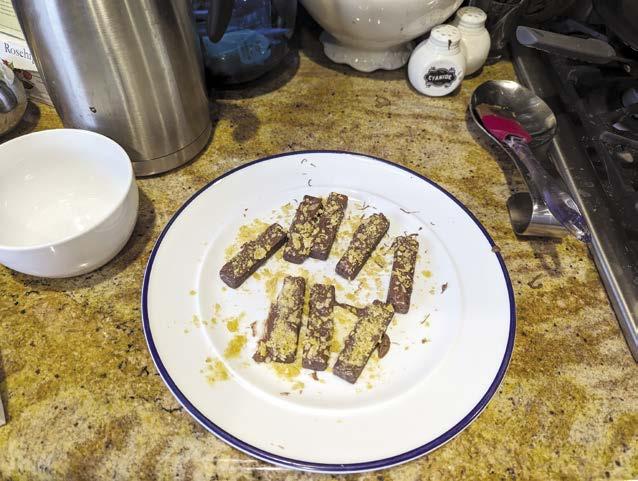 BY s CO tt s AAVEDRA
BY s CO tt s AAVEDRA
and treats we used to crave when we were younger but aren’t around anymore. Like a sweet and craveable Judge Crater, they just disappear and no one hears from them again. Mother’s Brand Flakey Flix cookies were my snack tragedy. Gone but not forgotten. Do you have a lost treat love? You’re not alone. There are plenty of hollow-eyed Retro Food Fans hoping against hope that one day their yummy delight will return. Searching for lost treats…? Well, that’s just part of my job.
The latest SUI (Snack Under Investigation) is Mr. Misty. It was a semi-frozen drink that was part soft-serve ice cream and part flavored slushy (think Slurpee), served up at Dairy Queen, an international chain of cold-treat and fast-food outlets. It Gone to the Big Sleep. But I ain’t convinced. The scuttlebutt is that Mr. Misty never went anywhere. The crazy part is that you won’t find it on any menu. Fans act as if it skipped town years ago.
So, is Mr. Misty with Elvis (if you take my meaning), or is Mr. Misty still around? Maybe it’s a ghost. The official Dairy Queen timeline makes no mention of Mr. Misty at all.
I pop some gum in my mouth. It’s bubblegum flavor and aspartame free. You’re expecting that I booze up while writing? That’s

a mug’s game—clear eyes are needed in this arena. There’s always some young punk Retro Investigator trying to get a jump on me. I’m ready to work.
I hit up the usual places—bars, dives, speakeasies, seedy gyms— and turned up nothing. I was left having to go where angels fear to tread… message boards and blog comment sections, a cesspool of poor grammar and worse punctuation. Luckily, more than one Mr. Misty fan was willing to sing:
“I remember Mr. Misty around 1971. They were sweet and tasty and cold. It was in Nova Scotia.”
“I knew they made ’em up in New England for years.”
“[As of 2007] they still have them in the Southeast. Be wary, they might try to put some whipped cream on top…”
“Political correctness killed Mr. Misty.”
“I remember getting them from A&W Root Beer.”
It’s clear that I needed to move on and shake a few different bushes when one of the messages grabbed me by the collar like an unhinged carbjunkie desperate for a “New Coke.”
“The Mt. Misty machine was originally called the DeLush… designed and first used in a Wichita, Kansas, Dairy Queen. One of the inventors was also the first person to put a hot kitchen in a Dairy Queen. I know this because he was my grandfather.”
This commenter, who goes by the internet handle “Michael,” doesn’t actually cough up the goods… a name for the inventor. Why so shy, “Michael?” You afraid of being a stoolie? Maybe you just got something to hide. Or you respect other people’s privacy. Either way I’m flummoxed. For starters, I can’t find hide nor hair of anything called a DeLush.
I don’t let a tight-lipped jamoke keep me from my search. I dig deeper. I go all the way back to the Big Bang of Dairy
Queen. Dairy Queen, or DQ as it’s more commonly known today, is the result of a raw passion for a new take on an old desert and a soda-pop disaster gone right. Those two events eventually collided into Mr. Misty. We know the names of the creators of Dairy Queen. But the inventor of the Mr. Misty has either been rubbed out of the public story or they are hiding in plain sight. Very strange. Very… Misty-rious (it’s my yarn, I’ll tell it like I tell it).
The DQ tale is a successful one. Not perfect. A little messy. But chaos creates opportunity. When you talk about the main joes at DQ in its early days, it’s a pretty small group. They’re my suspects.
1927 was a crazy year. The first armored car robbery happened, actress Mae West spent ten days in the pokey for “corrupting the morals of youth” via her play Sex, and The Jazz Singer starring Al Jolson was the first motion picture with synchronized sound. Less celebrated was Grandpa McCullough—all of 56 years old—who started making and wholesale selling ice cream that year.
More formally, Grandpa was known as J. F. (John Freemont) McCullough. He was born in Douds, Iowa, in 1871. Grandpa and his son Alex began making their own ice cream in Green River, Illinois, using milk from nearby farms. In order to get the fresh ice cream into their containers for later resale, it had to be soft enough to pour.

From there it would be frozen and sent to retail customers. Over time Grandpa developed a taste for the soft stuff. It wasn’t illegal, so he thought that maybe the general public would also like this soft ice cream.
He asked one of his ice cream clients if he would go in with him on a little job. It would be an audacious plan, but if it worked they all could maybe, just maybe, pull in a few banknotes.

Sherwood Noble owned an ice cream store in Kankakee, Illinois. He was better known as Sherb and bought his ice cream from Grandpa. He was all in with Grandpa’s plan, which was to see if the locals would give up cold, hard dough for some cold, soft serve.


end up just being a fad. He sold territorial rights to operate Dairy Queen stores to others. The company’s growth was modest, but this was more due to the war effort during the Big One making important components of the business difficult to get than a lack of interest. Added to these obstacles a stronger plan for growth was not only needed, but Grandpa, now 72, wanted to skip out from the day to day of the biz and take it easy.
Another random discovery during a drive would allow Grandpa to retire.
The war was leaving farm equipment sales manager Harry W. Axene without enough product to move. He was open to other opportunities when he happened across a busy Dairy Queen. Harry liked the product and wanted a piece of the action. After a face-to-face conversation with Grandpa on his porch, Harry (who must have been a heck of a pitchman) walked away with a deal for ownership of half of Dairy Queen’s business and his own Dairy Queen territories.
Once the war ended, Harry oversaw huge growth for the company. Soft-serve ice cream was a definite hit. But Dairy Queen was not a franchise in the top-down way for which McDonald’s would eventually become famous. The various store owners were not required to adhere to total menu sameness. This product fluctuation between the different outlets was confusing to customers and owners alike. But I gotta admit, it did allow for some tasty experimentation.
And at a Dairy Queen outlet that had seen better days a simple discovery would lead to the second component of the Mr. Misty.
Following his discharge from the Army, Omar Knedlik tried a number of businesses before purchasing a previously owned Dairy Queen in Coffeyville, Kansas. There are two versions of what happened next. The first, spread wide like butter on toast, is that his shop didn’t have a soda dispenser, so he put bottles of soda in his freezer where the beverages only sort of froze. The second is that Omar did have a soda machine but it broke, so he gathered


up bottles of soda and put them in his chest freezer. His widow confirmed the later version in an Associated Press story in 1991. In either scenario, customers really liked the icy drinks.
The sodas didn’t freeze solid due to the sugar content and the carbonation remained in the drink. Omar felt he was on to something, but it took five years of work and the eventual help of the John E. Mitchell Company in Dallas, Texas, to develop the proper equipment.
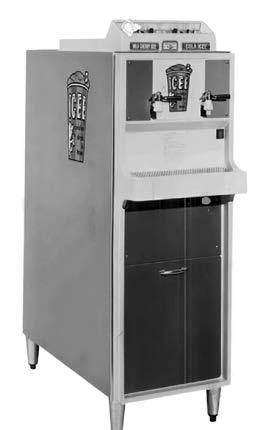
With the technical problems solved, a name for the new frozen treat was needed. Early suggestions were “Fizz” (already trademarked) and “Scoldasice” (!). Omar may have lacked a bit as a marketer, but thankfully a friend, artist Ruth Taylor, came up with the “Icee” name and its logo. At first ICEEs were a tough sell. A Coke dispenser in the early Sixties cost less than $800, while the ICEE machine cost a few thousand. But the drink caught the attention of the Southland Corporation, which then owned the 7-Eleven convenience store business. In 1965 they licensed the ICEE dispensers but called their product Slurpees, which were a hit. After that, ICEE’s also began to take off.
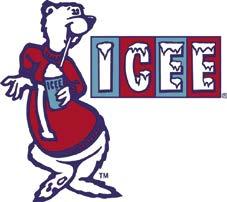

 BY RICK GOLD s CHMID t
BY RICK GOLD s CHMID t
Rankin/Bass’ Frosty the Snowman was “born” on December 7, 1969, on the CBS television network. This year, 2023, marks its 54th annual airing, making it the longest-running annual TV special on the same network (with Santa Claus Is Comin’ to Town, which premiered in 1970, being second, on ABC-TV). Happy Birthday!
Both Rankin/Bass’ Rudolph the Red-Nosed Reindeer [which originally premiered in 1964 on NBC; see RetroFan #12—ed.] and Frosty the Snowman get high ratings annually on CBS-TV.
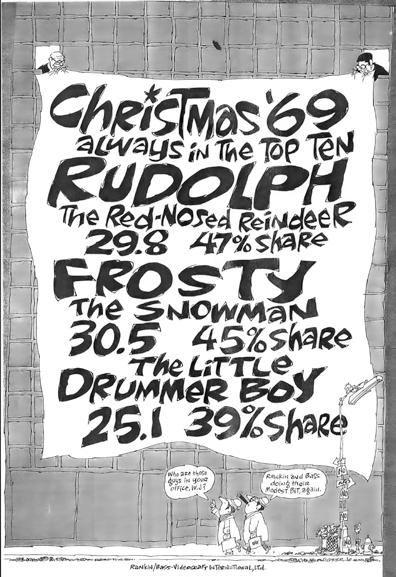
As the official Rankin/Bass historian/biographer, I am often asked: After the success of the stop-motion (“Animagic”) Rudolph, why did Rankin/Bass Productions choose cel animation for the Frosty special? “I wanted it to look like a Christmas card,” said producer Arthur Rankin, Jr., “and [MAD magazine artist] Paul Coker, Jr. was actually doing art on Christmas cards for Hallmark. Paul’s art was also more animat-able in traditional cel animation than, say, Jack Davis’ art, which was more detailed than Paul’s style.”

(LEFT) Holiday ratings bragging rights from Rankin/Bass, from a 1969 Variety ad. (RIGHT). Five years later they were at it again! Both ads feature art by MAD ’s Paul Coker, Jr. © Miser Bros. Press/ Rick Goldschmidt Archives.
Another reason for Frosty the Snowman’s cel animation was the that Rankin/Bass’ MOM Animagic studios in Japan was already busy doing an Animagic production, Santa Claus Is Comin’ to Town, after completing The Little Drummer Boy. [Editor’s note: See RetroFan #24 for the Little Drummer Boy story… and join us next Christmas for Rick Goldschmidt’s look at Santa Claus Is Comin’ to Town, in RetroFan #36!] For Frosty, Rankin/Bass Productions hired Mushi Studios in Japan, after doing many projects with Toei Studios (The King Kong Show, Cricket on the Hearth, The Mouse on the Mayflower, etc.). Mushi was far better at capturing the Paul Coker, Jr. art style in animation than Toei. For Frosty, Coker not only designed the characters, he also did the lettering in the credits, on buildings, etc. With this special, Paul’s art became the look with which Rankin/ Bass Productions would be closely linked. It was at this point that the illustrator began doing yearly Variety magazine ads for the studio. “When I told people I worked on Frosty the Snowman, their ears would perk open,” Coker said. “People were so enchanted by the Rankin/Bass TV specials. I began working with MAD magazine in 1962, but it was the Rankin/Bass work I did that really caught people’s attention!”
(OPPOSITE) Merry Christmas! Or should we say, Happy Birthday? Meet Frosty, Karen, and Hocus
Pocus from Rankin/Bass Productions’ Frosty the Snowman! © Miser Bros. Press/Rick Goldschmidt Archives.
Artist Paul Coker, Jr. chills out with Frosty in this sketch illustrated for Rick Goldschmidt. (INSET) Coker flashes a smile during a promotional appearance. © Miser Bros. Press/Rick Goldschmidt Archives.
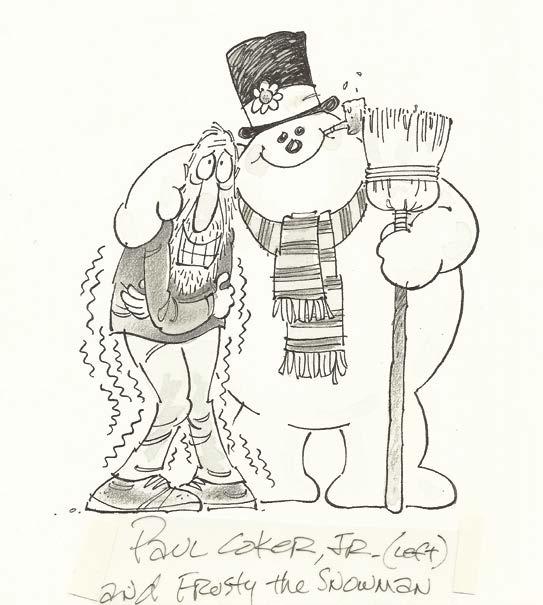

Chicks dig the car— and its handsome hotrodder! Super Collector Michael Knight’s KITT replica, plus a standee of Knight Rider ’s Michael Knight, actor David Hasselhoff.

When Knight Rider debuted on NBC-TV on September 26, 1982, viewers were introduced to Michael “one man can make a difference” Knight (who has the same name as this author!), played by David Hasselhoff.
The show’s premise: Hasselhoff’s character was ex-police officer Michael Long, who was presumably killed in the line of duty. He was actually chosen for service by self-made billionaire Wilton Knight, the founder of F.L.A.G. (the Foundation for L aw And Government). Michael Long was reborn as Michael Knight, who would use F.L.A.G.’s resources to become that “one (who) can make a difference,” helping others get justice from those who believed they were above the law. After Wilton Knight passes on, Michael’s new boss is Devon Miles, played by the wonderful Edward Mulhare, and Michael Knight is ready for his assignments as Knight Rider begins its run. But before Michael can hit the road and start righting wrongs—he’s going to need a set of wheels.
BY MICHAEL K n IGH tEnter Knight Industries 2000, better known as KITT, the super-car of the future (well, it was back in 1982!). KITT would be Michael’s trusted partner, in a sense the “Silver” to Hasselhoff’s “Lone Ranger.” Actor William Daniels provided KITT’s voice.
Michael did have help with his crusade other than KITT and Devon Miles. For three seasons of Knight Rider, actress Patricia McPherson played technician Bonnie Barstow, who kept KITT running and operational, and for one season, Rebecca Holden stepped in as April Curtis in a similar capacity. And the fourth season saw the addition of Peter Parros to join the fun!
But other than handsome Hasselhoff in the lead, it is KITT that most people think of when remembering Knight Rider —or the car is what catches their eye if they stumble across the show for the first time today. It was a brand-new 1982 Pontiac Trans Am that was redesigned into KITT, which has since become one of the most iconic television cars of all time.
Welcome back to Andy Mangels’ Retro Saturday Morning, and prepare for a visual feast! Saturday morning television was appointment viewing for anyone growing up from the Sixties to the Nineties. From 8 a.m. to noon, while their parents slept in from the workweek, kids could sit in front of the television and enjoy a time just for them. Cartoons—and later, live-action series—were produced by studios like Filmation Associates, DePatie-Freleng Enterprises, Total Television, Jay Ward Productions, HannaBarbera Productions, Sid and Marty Krofft, D’Angelo Productions, Marvel Productions, Sunbow Productions, Ruby-Spears, DIC, Film Roman, and others.
But how could the networks best reach kids to let them know when the new shows would be airing? Enter the television ads that ran in the comics, touting new and exciting Fall seasons! It made sense, since many shows were adapted from comic books!

For most kids, those two-page spreads were their first looks at future TV favorites. In the second of a regular annual series, we’re offering you a rare look at every Saturday ad we can find from 1970–1974!
(ABOVE) This rare ad for ABC’s 1970 Saturday morning line-up season—beginning on September 12th—didn’t appear in any comic books; it only appeared in some color newspapers!
(BELOW) Since Archie Comics had three TV series on CBS in the Fall 1970 season—debuting September 12th—the network took out double-page ads for the line-up. Archie also did its own one-page ad, challenging readers to be critics of the new shows!






 BY s CO tt s HAW!
BY s CO tt s HAW!
In retrospect, there was never more diversity of genres on the spinner racks than in the mid-Fifties through the mid-Sixties. Other than romance comics and Harvey’s kiddie comics—welldrawn but aimed at very young kids—I liked a bit of every genre from every publisher.
Around the same time as the price switch, in July of 1962 there was a new brand at the newsstands, Gold Key Comics. Mysteriously, Gold Key was publishing a lot of the same characters and series that Dell Comics had been making the month before. Even better, the comics were as good or better than their Dell incarnations, with cool, somewhat experimental covers. Around the same time Dell Comics suddenly changed, with a few old characters and lots of new titles, original, licensed, and adaptations. Edited by L. B. Cole, many of the dramatic series were well written but extremely dark, certainly rare for the Dell that we once knew. And even more unlike the original Dell, the majority of its humorous comics looked amateurish at best. However, Dell did occasionally hire top talent, such as Sam Glanzman, John Stanley, Dave Berg, George Evans, and others.
What we didn’t realize was going on behind the scenes is well explained by writer and comics historian Mark Evanier: “Western [Publishing] was a printing company with the editorial capability to create the content of the comic books. Dell was a publishing company that did many kinds of magazines and books. They bought their comic-book line from Western. In 1962, following a dispute about money, Dell and Western parted company. Dell hired editors, writers, and artists. Then they found themselves a new printer and started a comic-book division from scratch.
Western kept what was essentially the same comic-book line going, financing it themselves, putting a ‘Gold Key Comics’ logo on covers… and making the changes they thought wise, since Dell was no longer telling them what to produce.”
getting a hold of the glory days of comic-book publishing that Dell had during the late [Forties and Fifties].”
Suddenly, Dell had a new rival, one that had made the original brand of Dell Comics successful. Both were primarily based on familiar characters from various forms of entertainment, as well as plenty of self-generated series.
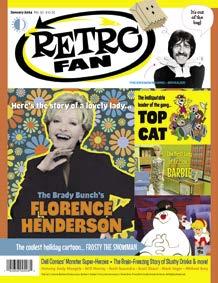
Don “D. J.” Arneson, who replaced Dell editor L. B. Cole in the spring of 1962, saw things from the inside: “My recollection is when I joined [the staff], Dell Comics was Dell Comics, plain and simple. Len Cole was the editor and I do not know for how long he had been the editor. I frankly don’t know the circumstances of what the split was about. That was between Len Cole and Dell. I don’t know what the break up was other than what I subsequently learned of the financial and ownership considerations. Dell broke with Western, Dell Comics maintained the Dell Comics logo. Dell created a new line of comics and a lot of what was published was an attempt of
(84-page FULL-COLOR magazine) $10.95 (Digital Edition) $4.99 https://twomorrows.com/index.php?main_page=product_info&cPath=98_152&products_id=1703
In 1962, Dell launched a wave of comic books officially licensed from Universal’s legendary monsters, starring Dracula, the Frankenstein Monster, the Wolf Man (a.k.a. Wolfman), the Mummy, and the Creature from the Black Lagoon. The stories themselves were far from canon, and unfortunately Bob Jenny’s art was bland and Jack Sparling’s artwork was muddy.
(LEFT) Dell Comics’ newest superhero busts loose in his “first” issue, Frankenstein #2 (Sept. 1966). Art by Tony Tallarico. (RIGHT) Of course, another man of steel had punched his way through no end of brick walls by the time ol’ Frankie got into the act. Superman TM & © DC Comics.
